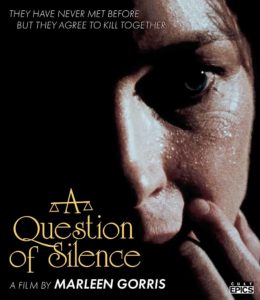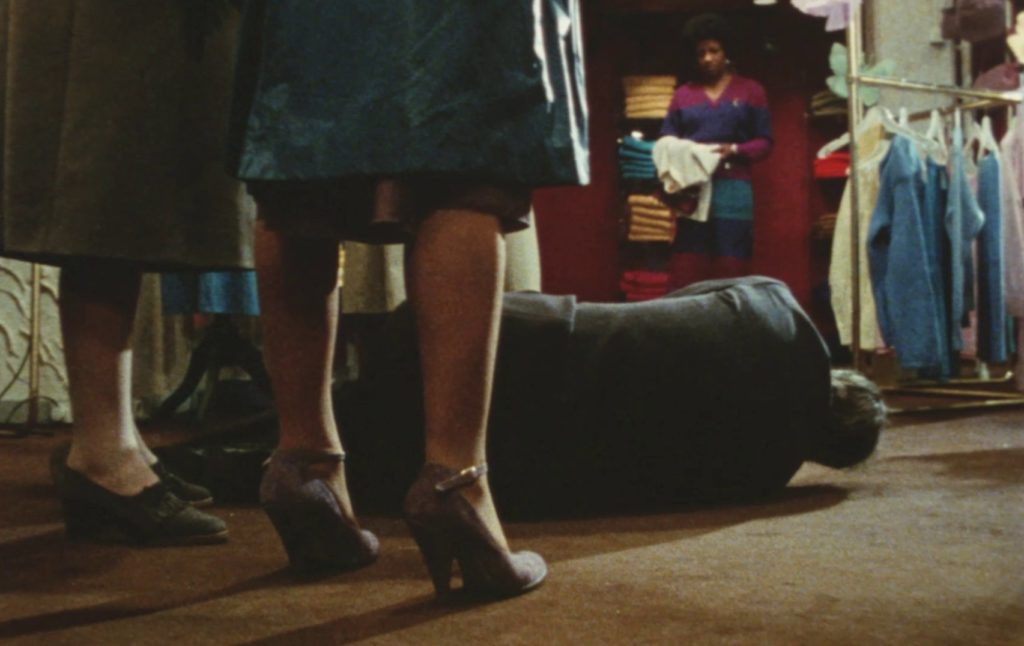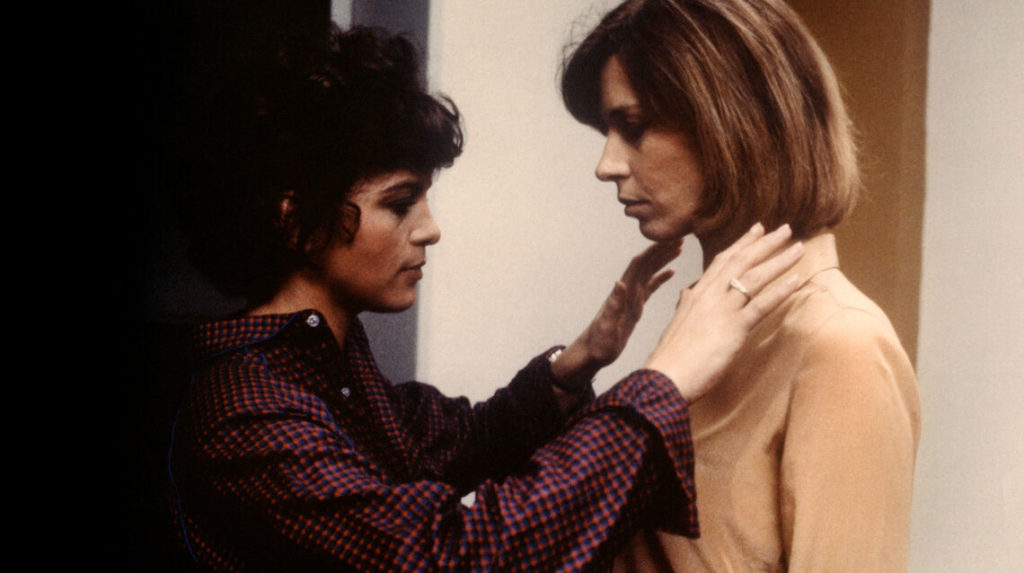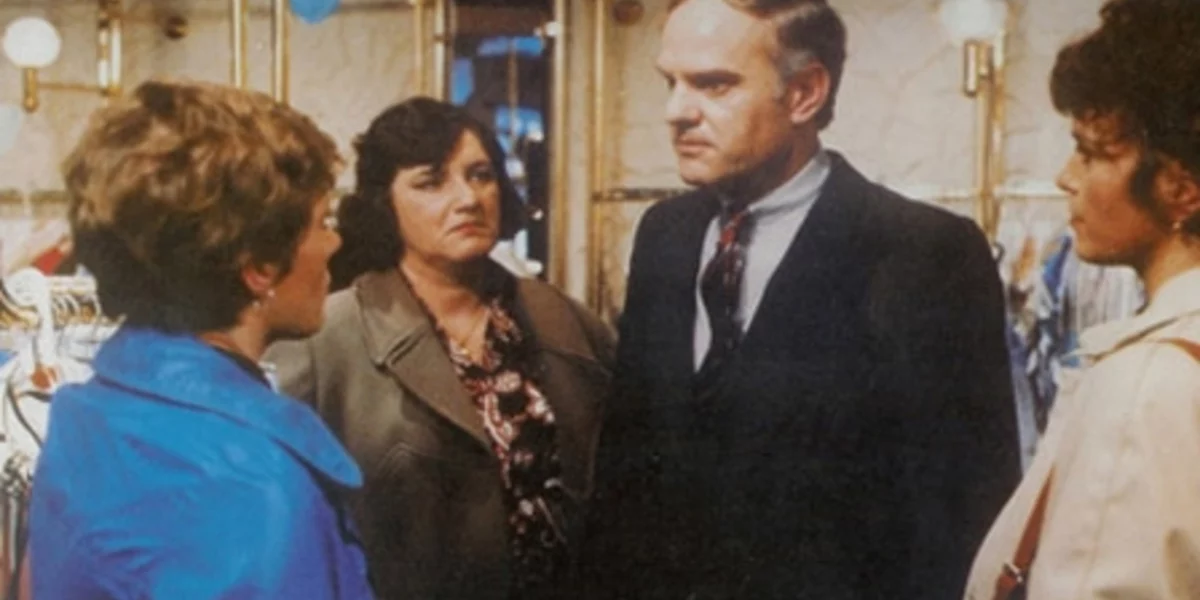Marleen Gorris’ Debut film is a Feminist Classic of Socially Motivated Murder
DIRECTED BY MARLEEN GORRIS/DUTCH/1982
BLU-RAY STREET DATE: JUNE 13, 2023/CULT EPICS

It’s said that the true purpose of art isn’t to give answers, but to ask questions. If you maintain, like we do, that movies are in fact art (a business too, but one fueled ideally by art), then you’ll likely agree that filmmaker Marleen Gorris’ A Question of Silence (1982; De stilte rond Christine M.) is one such movie that gets at the very heart of the matter. It’s right there in the title.
A supremely taut and endlessly gripping ninety-two-minutes, Gorris wrote and directed this debut film when inspired by a real-life crime story about ordinary women who one day murdered a man in a clothing boutique. The question, both in real life and in Question, is of course “why?”. In meted out flashbacks, we eventually arrive at the moment when three total strangers from three entirely different walks of Amsterdam life unspokenly unite in improvised, spur-of-the-moment homicide against the shop owner. A stifled executive secretary. A burnt-out housewife and mother. An overworked waitress in a greasy diner. (Respectively and hauntingly played by Henriëtte Tol, Edda Barends, and Nelly Frijda). On the surface, these three had nothing in common. Female repression, however, knows no bounds. To them, any prison they may end up in can’t be as bad as their lives of overlooked, invisible indentured servitude. At least there, they won’t have to cook. They’ll be taken care of.
Actress Cox Habbema’s character Janine, an appointed criminal psychiatrist, must work her way to some sort of definitive answer. In this extended process, the decidedly unglamorous world of institutionalized psychiatry takes center stage. Along the way, we get glimpses of Janine’s own spotty marriage, and the perplexity she feels in attempting to unravel the case. Can it be that this trio of arbitrary murderers are, in fact… ordinary?

During the scene of the crime, a very certain directorial attention is paid to female onlookers in the shop. While they do not join in, they also do not intervene in any way. They simply stand by, later reappearing like some kind of mute Greek chorus. Per the circulated version of how the killing occurred, no one else was present. But we know better. These four additional women are the film’s grand wild cards, both another question and the titular silence. What will they do? Will they come forward? One thing we know: they too become united around the incident. They saw in full gory detail what Gorris’ camera spares us: the futility of the human body against casual brutality dished out with broken clothes hangers, the sharp end of display racks, the lethal edge of a shattered glass shelf, and more. Maybe if the shop owner wouldn’t have been such a smug jerk when he caught one of the primary three women shoplifting, he’d still be alive. Just like maybe if another of the three dressed differently and carried herself differently on the street, she wouldn’t get propositioned as a presumed hooker. Both those statements may have some truth in them but are more-so belied by judgmental garbage. Sometimes, silence really is golden.
With a very grainy 16mm look (this Blu-ray release utilizing a 2K HD transfer and restoration) and period-contemporary mundane fashions, hair styles, and locales to match (the visions of the country’s austere, lonely white tenement buildings resonate like something out of bleak science fiction), Gorris tells her story with a starkly appropriate minimalist touch. The only iffy element in the whole mix is the electric synthesizer score, which definitely has its great moments, but just as often sticks out like an ominous sore thumb. Whhhaaaauuuuuuhhhhhhhhhh.
Dutch film scholar Patricia Pisters has an optional English audio commentary track that is both dense with information but also very sporadic in terms of silent stretches. At least part of that is likely due to the language barrier, though there is no difficulty whatsoever in understanding and following Ms. Pisters succinct points. When she doesn’t have anything to say about A Question of Silence, she takes the opportunity to paint a broader picture of the very male-centric Dutch cinema landscape to which Gorris arrived. Included other titles include Wim Verstappen’s tremendous hit Blue Movie and Paul Verhoeven’s even bigger hit, Turkish Delight. She of course also discusses Gorris’s subsequent work, including the revered 1995 release and Oscar winner of Best Foreign Language Film, Antonia’s Line, and the director’s second release, Broken Mirrors.

Also included as extras on Cult Epics’ must-get Blu-ray are two brief 1982 promotional chats with Gorris and Habbema on a television program called Cinevisie. These segments allow us a glimpse into how such direct film marketing has, in large part, degenerated into useless vapidity since the time of these interviews. At least one other very short clip is also included, as is a stills gallery and the film’s trailer. Related Cult Epics are also available to view. A few minor spelling or grammatical errors were spotted in the English subtitles; far from any kind of dealbreaker. Viewers have the option of the film’s original LPCM 2.0 mono audio track or a newly created DTS-HD MA 2.0 mono track.
An auteur-minting career-launching effort for Gorris, A Question of Silence must be on the shortlist of finest films that Cult Epics has ever released. I have absolutely no hesitation in stating that the title is one that would absolutely make the cut with Criterion, particularly amid its current scramble to make up for lost time in releasing films by women. But Cult Epics got to it first, and did every bit as well by it (sans an essay booklet). If Gorris’ first film seems out of step with Cult Epics’ perceived sensibilities, look again. A Question of Silence stands among the most deeply incendiary films ever made. (When Gorris pitched her screenplay to Chantal Akerman, Akerman wisely told her that she must make it herself). While never advocating for murder as a solution to widespread women’s social immobility, it does dare to ask us to consider why they’d get to such a point. Its own flirtation with ethical extremity marks A Question of Silence as a tantalizingly disturbing and unanswerable (yet very answerable) query to the plight of twentieth century women. In her oblique and immersive visual storytelling, Gorris tells us all we need to know of the “why” of it. The question remaining for us lies in our collective silence.


